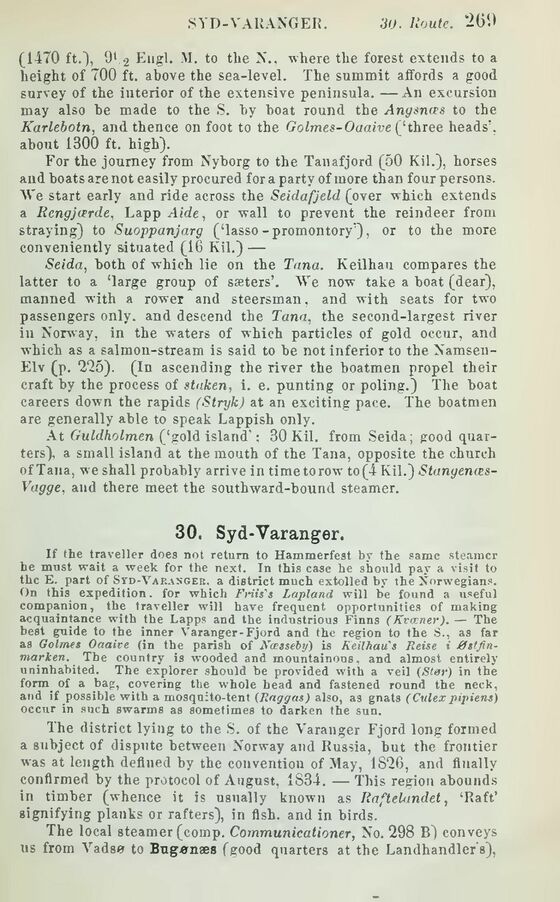
Full resolution (JPEG) - On this page / på denna sida - Norway - Pages ...

<< prev. page << föreg. sida << >> nästa sida >> next page >>
Below is the raw OCR text
from the above scanned image.
Do you see an error? Proofread the page now!
Här nedan syns maskintolkade texten från faksimilbilden ovan.
Ser du något fel? Korrekturläs sidan nu!
This page has never been proofread. / Denna sida har aldrig korrekturlästs.
(1470 ft."), 9*2 Engl. M. to the N., where the forest extends to a
height of 700 ft. above the sea-level. The summit affords a good
survey of the interior of the extensive peninsula. — An excursion
may also he made to the S. by boat round the Angsnas to the
Karlebotn, and thence on foot to the Golmes-Oaaive (‘three heads’,
about 1300 ft. high).
For the journey from Nyborg to the Tanafjord (50 Kil.), horses
and boats are not easily procured for a party of more than four persons.
V>’e start early and ride across the Seidafjeld (over which extends
a Rcngjarde, Lapp Aide, or wall to prevent the reindeer from
straying) to Suoppanjarg (‘lasso-promontory’), or to the more
conveniently situated (16 Kil.) —
Seida, both of which lie on the Tana. Keilhau compares the
latter to a ‘large group of sæters’. We now take a boat (dear),
manned with a rower and steersman, and with seats for two
passengers only, and descend the Tana, the second-largest river
in Norway, in the waters of which particles of gold occur, and
which as a salmon-stream is said to be not inferior to the
Namsen-Elv (p. 2^5). (In ascending the river the boatmen propel their
craft by the process of staken, i. e. punting or poling.) The boat
careers down the rapids (Stryk) at an exciting pace. The boatmen
are generally able to speak Lappish only.
At Guldholmen (‘gold island’; 30 Kil. from Seida; good
quarters), a small island at the mouth of the Tana, opposite the church
of Tana, we shall probably arrive in timetorow to(4 Kil.)
Stangences-Vagge, and there meet the southward-bound steamer.
30. Syd-Varanger.
If the traveller does not return to Hammerfest by the same steamer
he must wait a week for the next. In this case he should pay a visit to
the E. part of Syd-Yarasgee. a district much extolled by the Norwegians.
On this expedition, for which Friis’s Lapland will be found a useful
companion, the traveller will have frequent opportunities of making
acquaintance with the Lapps and the industrious Finns (Kvæner). — The
best guide to the inner Varanger-Fjord and the region to the S., as far
as Golmes Oaaive (in the parish of Nanseby) is Keilhau’s Reise i
Øs!finmarken. The country is wooded and mountainous, and almost entirely
uninhabited. The explorer should he provided with a veil (Støv) in the
form_ of a bag, covering the whole head and fastened round the neck,
and if possible with a mosqnito-tent (Raggas) also, as gnats (Citlexpipiens)
occur in such swarms as sometimes to darken the sun.
The district lying to the S. of the Varanger Fjord long formed
a subject of dispute between Norway and Russia, hut the frontier
was at length defined by the convention of May, 1S26, and finally
confirmed by the protocol of August, 1S34. — This region abounds
in timber (whence it is usually known as Raftelandet, ‘Raft’
signifying planks or rafters), in fish, and in birds.
The local steamer (comp. Communicationer, No. 298 B) conveys
us from Vadsø to Bugønæs (good quarters at the Landhandler"s),
<< prev. page << föreg. sida << >> nästa sida >> next page >>